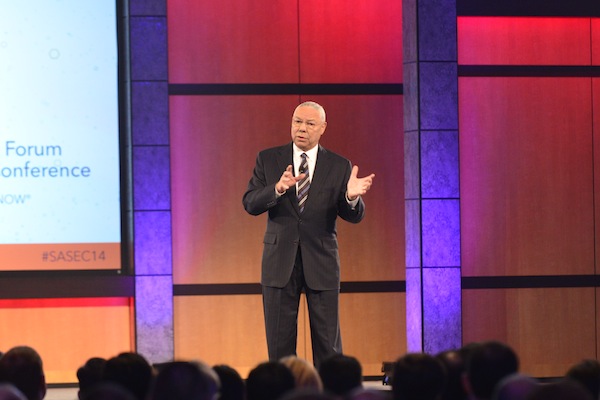
I was delighted to spend a couple of days at the SAS Global Forum in D.C. this week, where I presented the story of agile marketing to their data-driven — really, truly data-driven — audience. (The Cliff-Notes version: Agile management methods mixed with good analytics are a potent combination. The technology is ready. The challenges now are human.)
While there, I listened in on an excellent keynote by Colin Powell.
Now, I’ve always liked Colin Powell when he was active in U.S. politics. But going into his keynote, I found myself wondering — as you might be — what he could possibly say that would be relevant to me professionally (and via this blog post, to you, dear reader)?
As it turns out, quite a bit.
A Secretary of State who knows how to program
First, this was a surprise to me, but Powell knows how to program in COBOL and FORTRAN. Okay, so his programming days were in the 1970’s. But still, I believe he is the first and only U.S. Secretary of State in history who’s had that skill set in his mental toolbox. (If you know of others, let me know — maybe John Kerry is a closet Rubyist?)
The Army asked him to learn computer programming as part of his graduate program (an MBA from George Washington University). But after graduation, rather than taking a programming role, he was moved into other leadership positions. He said that the Army intentionally sought to cross-pollinate ideas and disciplines with such rotations.
My two takeaways from that:
- More organizations should cross-pollinate “programming sensibility.”
- Having senior leaders who are proud of their technical skills — and not just in web start-ups — builds cultural acceptance of tech-savviness at a much broader scale.
On building a 21st century State Department
He also shared the story of when he became Secretary of State and discovered that, as of 2001, the State Department was woefully behind in its technology. One of his first actions as Secretary was to make sure that nearly employee in the organization had a computer — they purchased something like 44,000 new machines. Because, after all, diplomacy is largely in the business of information.
“I changed the hardware, changed the software — and then I had to change the brainware,” he said. Since many staff members weren’t used to being connected this way, it was a shift in culture to gain adoption.
Powell made a point of using their new internal systems himself to demonstrate top-level commitment. When he would visit any diplomatic outpost, one of the first things he would do is go into the office of a random staffer and ask to get connected through their machine — it was a pass/fail spot inspection to make sure people had their systems ready and knew how to use them. Because he made a big deal out of this, the rest of the organization made a big deal of it too.
My takeaway: the real challenge in technology adoption is changing “brainware.” There’s no better way to do that than demonstrated commitment from the executive team — actions, not just words.
A combination of data and human judgment
General Powell and I are definitely on the same page when it comes to data. He’s a vocal advocate of leveraging technology and incorporating data into decisions. “I am a glutton for information,” he said. However, when it comes to making decisions with data, he stressed the importance of human interaction and judgment. “It is the human element that looks at the data and asks, ‘Does this make sense?'”
Given a world of tremendous information, but not always perfect information, he stressed the importance of differentiating between what is known and what is speculated. He would gather all the data he could, but when it came time to make a final decision, he would rely on instinct to synthesize the data into an answer. “An instinct is not just a guess,” he noted. When based on data and experience, it’s a highly “informed instinct.”
“The most powerful business analytic tool we have is the human brain.”
A key source of data that he emphasized was the front line. As a general, he would regularly go to soldiers on the front line to hear what they thought. He felt that things could be lost in translation when they were filtered reported up the chain of command — intentionally or inadvertently — and that it was important to tap the fidelity of first-hand perspectives.
“The line is always right,” he declared. “I want the ground truth, and the truth is out on the ground.”
My two takeaways here:
- Use the data, but don’t always trust the data.
- The ground truth is not on your dashboard. It’s on the front line with your customers and employees. Get up from your computer and go talk with them.
The 15-minute daily stand-up at the State Department
Near the end of his presentation, Powell made a remark about having a daily 15-minute meeting with his top staff every day. My “agile detector” started blinking brightly.
I have no idea if they did this standing up, or whether it was part of a broader embrace of agile methodologies. But the intent was very agile: transparency. “If there’s an issue faced by an ambassador in Europe, I want the head of African diplomacy to be aware of it.”
In combination with Powell’s advocacy for empowering subordinates — even at a relatively low-level in the organization — and eagerly seeking out feedback from the front line, I couldn’t help but conclude that he was an agile manager (or at least deserved that as an honorary title).
My takeaway: if agile values are embraced by a top general and the U.S.’s most powerful diplomat, they’re probably worth considering in your organization too.



“The technology is ready. The challenges now are human.” As always!
Scott, it is always great to read your content. As usual, it delivers insights and examples that are useful. The one snippet I would add, though General Powell implies it and you relate it, is the value of self organizing teams. I have lead Scrum, XP and Kanban teams for years and it isn’t just that the “front line is always right” or empowered. It is deferring decisions to the team and mentoring them into making changes without approvals. Toyota’s engineers don’t ask for permission to make a change or “stop the line.” They are expected to change it and considered to be cheating if they don’t. I know you have covered this in you fantastic posts and presentations but unless, and until, marketing firms are willing to let their teams decide, they will be followers not leaders in the agile movement.
The purpose of agile marketing is to improve the speed, transparency, predictability and adaptability to change of the marketing function. For agile marketers a process is design to increase alignment with the business aims of the organization. This process also iterative, allowing for short marketing experiments frequent feedback.